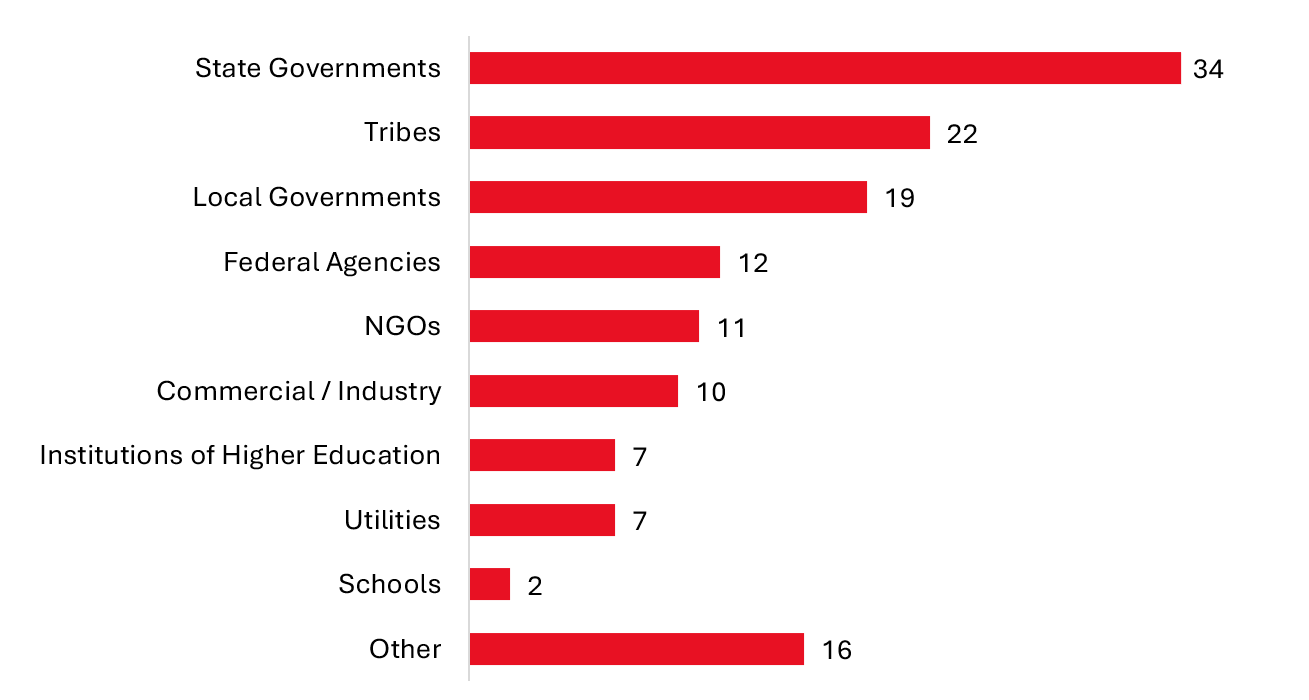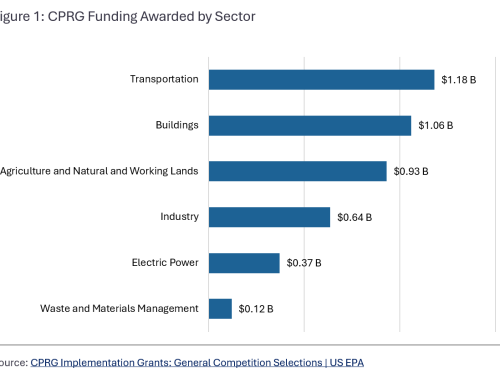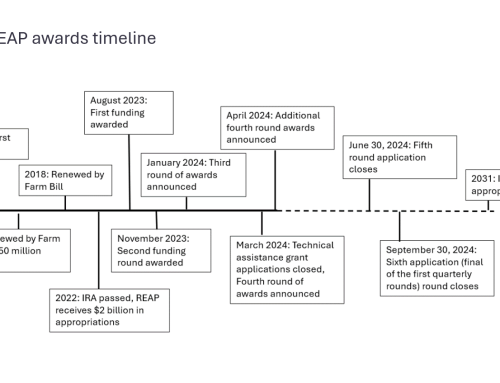
This figure depicts the 65 IIJA programs with climate-related funding grouped by their federal cost share. The 26 programs tracked on the Portal that do not have funding attached are not shown. Multiple refers to programs that have different federal cost share depending on the type of project or sub program.
By popular request, we have added new data on the match requirements and eligible recipients for each IIJA program.
In conversations with grantees, there is a consistent need to understand who is eligible to receive funds and how much recipients will need to contribute in cost share to access those funds.
That need is even more pronounced for programs where state governments must contribute matching funds. Many states are in the midst of their legislative sessions and will need to appropriate or dedicate matching funds in order to pursue IIJA funding later this year. The need for matching funds is already creating friction in states where there may be opposition from the legislature to match funding provided by the federal government.
In our initial Spotlight, we spoke with North Carolina grantees including Brian Buzby. He mentioned,
“For us here in a red legislative state we’re worried about all the funding. We are concerned that it could even just get tied up or a state match doesn’t get made available. We dealt with this with our Volkswagen Settlement funds. We are just years behind blue states getting that money out the door because the legislature sat on it and then got into a tussle with our Democratic governor so for us we’re just trying to figure out what does the legislature actually have some control over. And I know the governor’s office has been asking us that same question.”
Just last week Minnesota’s legislature adjourned without acting on spending bills that would have set aside part of the state’s budget surplus towards matching funds for IIJA. Advocates have since called on Governor Walz to convene a special session to follow through on these bills. Elsewhere, Wyoming has appropriated funding during the most recent budget session including, “more than $200 million in matching funds for grant applicants. There was $100 million allocated for energy, $75 million for infrastructure, $25 million for broadband and $10 million for wildlife crossings.” Nearby in Oregon, the state’s Department of Transportation has authorized funds to support EV charging – that is the required 20 percent match for their National Electric Vehicle Infrastructure (NEVI) funding. If you have seen states appropriate (or struggle to appropriate) funding for IIJA programs, let us know!
Before we dive in, a reminder that in the Portal, we are tracking 91 sections worth $145.6 billion.
How much will the feds cover?
Of the 91 sections, 65 have funding attached. The mode (most common) tracked on the Climate Program Portal is 80 percent federal share followed by 50 percent federal share. The 80 percent benchmark is often a default for federal programs. For example, the Energy Policy Act of 2005 sets the default cost share for the Department of Energy at 80 percent for research and development projects and 50 percent for demonstration and commercial projects. Where it was not explicit in the Act text, we looked at the White House Guidebook for guidance on the federal cost share.
While these numbers represent the standard cost share for each program, many programs have exceptions. First, there are those programs where there are carve outs to account for disadvantaged applicants. Take for instance the Healthy Streets Program or the Local and Regional Project Assistance. The federal share is 80 percent however for applicants demonstrating hardship, the Secretary may cover up to 100 percent of the funding. In some cases, some geographic regions are slated for greater federal support. In the Rural Surface Transportation Grant Program, the standard is 80 percent federal cost share but projects on the Appalachian Development Highway System and Denali access system (Alaska) may receive 100 percent federal cost share. Also worth noting that the match grants do not necessarily require a state to match the funding. For instance, the NEVI program has an 80 percent federal share. This means that another entity must pitch in the other 20 percent. Montana is requiring that this cost share is borne by private entities (presumably the charging provider), whereas the Oregon Department of Transportation appears to be stepping in here (as mentioned above).
Then there are initiatives that have different funding support based on the type of element within the program. Take for instance the Electric drive vehicle battery recycling and second-life applications program. For this program, the Cost share is 50 percent for demonstrations and commercial applications and 80 percent for research and development. Likewise for the Reconnecting Communities Pilot Program, there is 80% federal share for planning grants (up to $2 million) and 50% federal share for construction grants (up to $5 million).
Then there are some that remain TBD, like the Carbon capture technology program. We anticipate that these programs will announce cost share requirements when the grant solicitations are released.
Finally, there are the 100 percent programs. For the most part, these eight programs appear to cover the whole cost of eligible projects and include the Clean School Bus Program and the Weatherization Assistance Program.
So why does it matter? If states aren’t able to meet the state share requirements for formula grant programs, then they may not receive their apportioned funding. For competitive programs that have a match requirement, applicants that cannot secure matching funds may not be able to compete for funding.
It is crucial that stakeholders understand the cost share requirements of each program and can begin to plan and anticipate the programs that will need legislative and budgetary support. We will continue to update this data as we learn more about the 22 programs where the federal share is not yet specified, and the four programs where different elements have different cost share requirements.
Who are the eligible recipients?
Eligible recipients vary widely across the programs. Eligible recipients range from government entities, to non-governmental organizations (NGOs), to the private sector.
For each of the 65 programs with funding attached, eligible recipients were categorized and tagged based on the text of the bill and the White House Guidebook. Eligible recipient refers to the entities that are eligible to apply for or receive funding directly. In some cases, other entities may be able to receive funds as either subgrantees or end recipients. The breakdown of eligible recipients is shown in Figure 2 below. Note that most programs have multiple eligible recipients.
Figure 2: Eligible Recipients by Number of Programs
This figure depicts the number of programs for which each category of recipients is eligible. Other refers to recipients that don’t fit into a defined category
State governments are eligible for more than half of all climate programs tracked on the Climate Program Portal and tribes are eligible for approximately a third.
NGOs are eligible for 11 programs including nine through the Department of Energy and one each through the EPA and the Department of Transportation. Commercial and Industry are eligible for 10 programs. On that front, Ashley Santa Cruz from Apex Strategic Consulting in Arizona has pulled together a useful tool to track opportunities as they arise for business. Here’s the upcoming requests for June 2022.
Utilities are eligible for seven programs all administered through the Department of Energy. These programs generally have a lower cost share than others (around 50 percent). As to be expected, the six formula funding programs that we are tracking are all open to states and tribes only. There are 26 programs that have a single eligible entity that can be funded and there is one program where there is no recipient specified: Reduction of Truck Emissions at Port Facilities. Other covers a range of groups, from Ports to public-private partnerships to metropolitan planning associations.
What other data are you looking for in the Dashboard? Get in touch!



